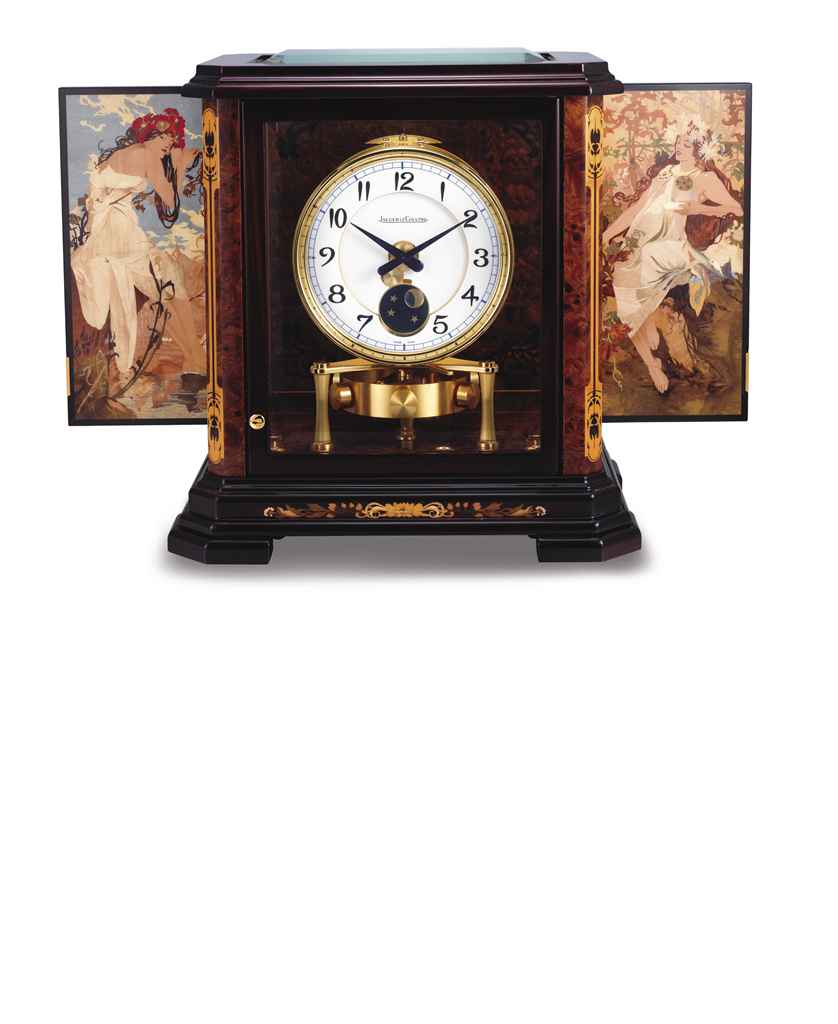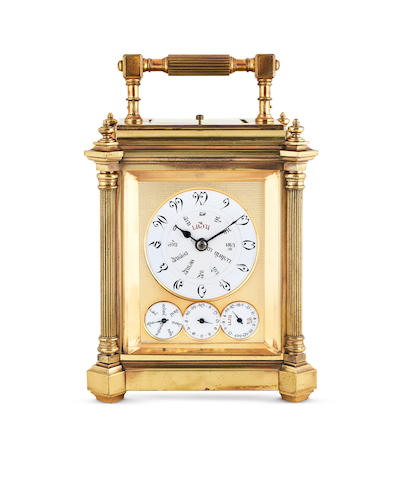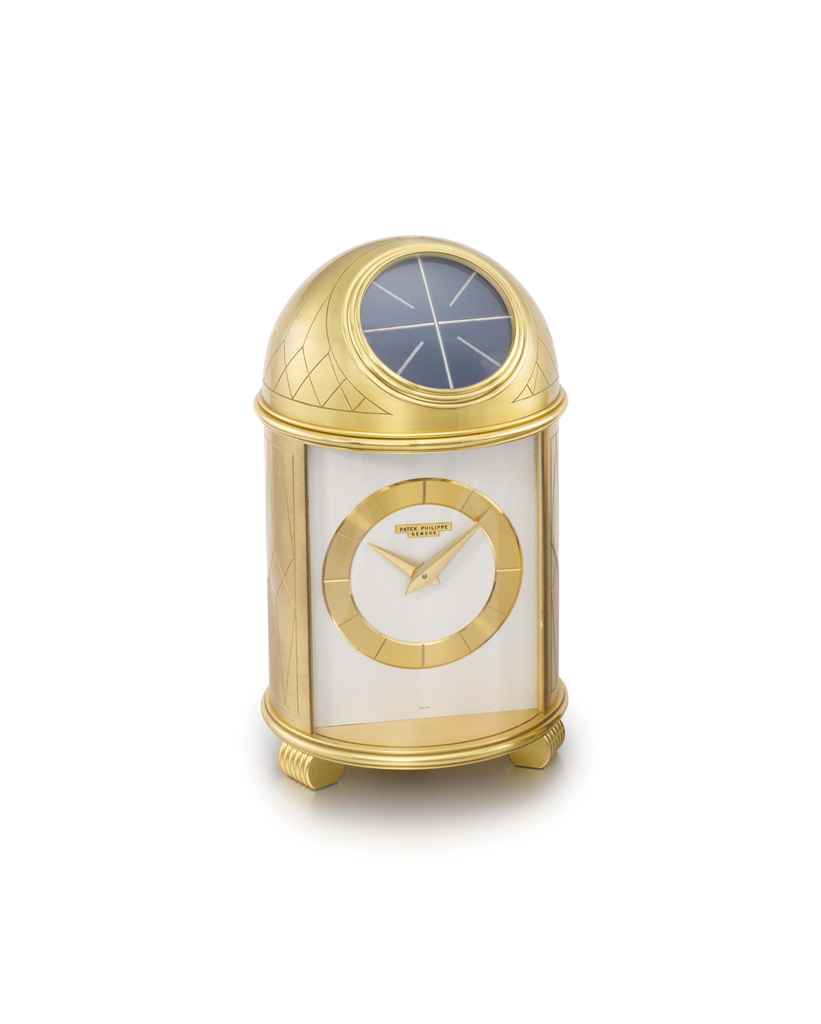A rare gilt brass mounted ebony alarm timepiece of month duration with silent-pull quarter-repeat, Thomas Tompion and Edward Banger, London, No. 92 The substantial six finned and latched pillar single fusee movement fully reinstated with large spring barrel and reversed fusee to the five-wheel going train with verge escapement regulated by lenticular bob pendulum with rack-and-pinion pivoted beam regulation to suspension, the quarter repeat mechanism to Tompions highly complicated all or nothing design sounding on a graduated pair of bells with the larger set between the plates and the smaller above, the alarm mechanism located beneath the larger bell with standing spring barrel and verge hammer assembly, the 8.5 by 7.25 inch backplate with canted upper angles over protruding bell to top left opposing rack box and shaped pivoted arm for the rise/fall pendulum suspension terminating above separate shaped cocks for guiding the suspension spring and for the escapement pallet arbor pivot, the centre with interconnected blue steel repeat levers pivoted via engraved sculpted cocks, the whole engraved by G195 (believed to possibly be Henry Adeane) with fine grotesque mask scrolling foliage within a line-scribed border and centred with an elaborate cartouche signed Tompion & Banger, LONDON over stamped serial number 92 to lower margin, the 8 by 7.25 inch rectangular brass dial with rose engraved silvered alarm setting disc and shaped false bob aperture to the finely matted centre within applied silvered Roman numeral chapter ring with cruciform half hour markers and Arabic five minutes beyond the minute track, with fine pierced and sculpted blued steel hands and crisp gilt female mask and scroll cast spandrels to lower angles, the upper margin with conforming cast spandrel infill interrupted by subsidiary dummy opposing regulation dials, each with complex rosette centres, flanking repeat signature TOMPION + BANGER, LONDON, with leaf engraved detailing to extreme upper corner, the gilt brass mounted ebony case of phase 2 type with generous hinged gilt brass tied foliate bud carrying handle to the domed caddy superstructure over bold ogee/ovolo top mouldings and front door incorporating lambrequin mask centred gilt foliate scroll cast lozenge sound fret to the upper rail and scroll-bordered cartouche escutcheon mounts to uprights, the sides with small scroll-pierced lozenge sound frets over rectangular apertures inset with conforming foliate pierced fretwork, the rear with rectangular glazed door set within the frame of the case, on shallow ogee moulded skirt base with squab feet, the sill beneath the front foot stamped 92 towards the left hand side, (movement with reinstated wheel trains and repeat work), 38cm (15ins) high excluding handle; 27.5cm (11.75ins) wide; and 16.5cm (6.5ins) deep. Thomas Tompion has often been referred to as the 'father of English clock and watchmaking'. When considering the legacy of his work and influence on subsequent generations, such a compliment is justly deserved. Born in Ickwell, Suffolk in 1639 Thomas Tompion appears to have developed an affinity for metalworking from his father, also named Thomas, who worked as a blacksmith. By 1670 Tompion had moved to London and was working in the clock and watchmaking trade. Although there is no record of his apprenticeship or whether he received any formal training prior to moving to London, he quickly became established and obtained his freedom of the Clockmaker's Company in late 1671. His early clocks demonstrate a close working relationship with the Fromanteel, East and Knibb workshops. Around this time Tompion became friendly with eminent mathematicians and scientists such as Robert Hooke and Jonas Moore - perhaps the most progressive and inventive minds of the day. Such associations lead to Royal commissions, firstly from Charles II for whom Tompion is known to have made one of the earliest balance-spring watches in 1676 and later William III who ordered nu
A rare gilt brass mounted ebony alarm timepiece of month duration with silent-pull quarter-repeat, Thomas Tompion and Edward Banger, London, No. 92 The substantial six finned and latched pillar single fusee movement fully reinstated with large spring barrel and reversed fusee to the five-wheel going train with verge escapement regulated by lenticular bob pendulum with rack-and-pinion pivoted beam regulation to suspension, the quarter repeat mechanism to Tompions highly complicated all or nothing design sounding on a graduated pair of bells with the larger set between the plates and the smaller above, the alarm mechanism located beneath the larger bell with standing spring barrel and verge hammer assembly, the 8.5 by 7.25 inch backplate with canted upper angles over protruding bell to top left opposing rack box and shaped pivoted arm for the rise/fall pendulum suspension terminating above separate shaped cocks for guiding the suspension spring and for the escapement pallet arbor pivot, the centre with interconnected blue steel repeat levers pivoted via engraved sculpted cocks, the whole engraved by G195 (believed to possibly be Henry Adeane) with fine grotesque mask scrolling foliage within a line-scribed border and centred with an elaborate cartouche signed Tompion & Banger, LONDON over stamped serial number 92 to lower margin, the 8 by 7.25 inch rectangular brass dial with rose engraved silvered alarm setting disc and shaped false bob aperture to the finely matted centre within applied silvered Roman numeral chapter ring with cruciform half hour markers and Arabic five minutes beyond the minute track, with fine pierced and sculpted blued steel hands and crisp gilt female mask and scroll cast spandrels to lower angles, the upper margin with conforming cast spandrel infill interrupted by subsidiary dummy opposing regulation dials, each with complex rosette centres, flanking repeat signature TOMPION + BANGER, LONDON, with leaf engraved detailing to extreme upper corner, the gilt brass mounted ebony case of phase 2 type with generous hinged gilt brass tied foliate bud carrying handle to the domed caddy superstructure over bold ogee/ovolo top mouldings and front door incorporating lambrequin mask centred gilt foliate scroll cast lozenge sound fret to the upper rail and scroll-bordered cartouche escutcheon mounts to uprights, the sides with small scroll-pierced lozenge sound frets over rectangular apertures inset with conforming foliate pierced fretwork, the rear with rectangular glazed door set within the frame of the case, on shallow ogee moulded skirt base with squab feet, the sill beneath the front foot stamped 92 towards the left hand side, (movement with reinstated wheel trains and repeat work), 38cm (15ins) high excluding handle; 27.5cm (11.75ins) wide; and 16.5cm (6.5ins) deep. Thomas Tompion has often been referred to as the 'father of English clock and watchmaking'. When considering the legacy of his work and influence on subsequent generations, such a compliment is justly deserved. Born in Ickwell, Suffolk in 1639 Thomas Tompion appears to have developed an affinity for metalworking from his father, also named Thomas, who worked as a blacksmith. By 1670 Tompion had moved to London and was working in the clock and watchmaking trade. Although there is no record of his apprenticeship or whether he received any formal training prior to moving to London, he quickly became established and obtained his freedom of the Clockmaker's Company in late 1671. His early clocks demonstrate a close working relationship with the Fromanteel, East and Knibb workshops. Around this time Tompion became friendly with eminent mathematicians and scientists such as Robert Hooke and Jonas Moore - perhaps the most progressive and inventive minds of the day. Such associations lead to Royal commissions, firstly from Charles II for whom Tompion is known to have made one of the earliest balance-spring watches in 1676 and later William III who ordered nu










.jpg)




Testen Sie LotSearch und seine Premium-Features 7 Tage - ohne Kosten!
Lassen Sie sich automatisch über neue Objekte in kommenden Auktionen benachrichtigen.
Suchauftrag anlegen